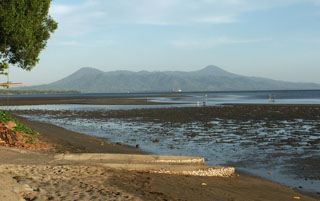Report on Krummel-Garbuna-Welcker (Papua New Guinea) — 9 July-15 July 2008
Smithsonian Institution / US Geological Survey
Weekly Volcanic Activity Report, 9 July-15 July 2008
Managing Editor: Sally Sennert.
Please cite this report as:
Global Volcanism Program, 2008. Report on Krummel-Garbuna-Welcker (Papua New Guinea) (Sennert, S, ed.). Weekly Volcanic Activity Report, 9 July-15 July 2008. Smithsonian Institution and US Geological Survey.
Krummel-Garbuna-Welcker
Papua New Guinea
5.416°S, 150.027°E; summit elev. 564 m
All times are local (unless otherwise noted)
Moderate to strong emissions of pale white to light gray ash clouds were observed from Garbuna on the morning of 13 July 2008. Summit activity was low between 1 and 12 July, when emissions consisted mainly of white vapor. The ash emissions on 13 July formed a column that rose about 1 km above the summit area. Seismic activity was generally very low during the corresponding period.
Geological Summary. The basaltic-to-dacitic Krummel-Garbuna-Welcker Volcanic Complex consists of three volcanic peaks located along a 7-km N-S line above a shield-like foundation at the southern end of the Willaumez Peninsula. The central and lower peaks of the centrally located Garbuna contain a large vegetation-free area that is probably the most extensive thermal field in Papua New Guinea. A prominent lava dome and blocky lava flow in the center of thermal area have resisted destruction by thermal activity, and may be of Holocene age. Krummel volcano at the south end of the group contains a summit crater, breached to the NW. The highest peak of the group is Welcker volcano, which has fed blocky lava flows that extend to the eastern coast of the peninsula. The last major eruption from both it and Garbuna volcanoes took place about 1800 years ago. The first historical eruption took place at Garbuna in October 2005.
Source: Rabaul Volcano Observatory (RVO)

